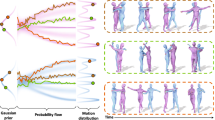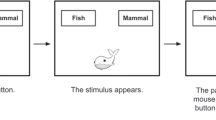Abstract
Human motion style is a vital concept to virtual human that has a great impact on the expressiveness of the final animation. This paper presents a novel technique that transfers style between heterogeneous motions in real time. Unlike previous approaches, our stylized motion warping is capable of reusing style between heterogeneous motions. The key idea of our work is to represent human motions with identity-independent coordinates (IICs) and learn relative space–time transformations between stylistically different IICs, instead of separating style from content. Once the relative space–time transformations are estimated from a small set of stylized example motions whose contents are identical, our technique is capable of generating style-controllable human motions by applying these transformations to heterogeneous motions with simple linear operations. Experimental results demonstrate that our technique is efficient and powerful in stylized human motion generation. Besides, our technique can also be used in numerous interactive applications, such as real-time human motion style control, stylizing motion graphs and style-based human motion editing.










Similar content being viewed by others
References
Amaya K, Bruderlin A, Calvert T (1996) Emotion from motion. In: Proceedings of the conference on Graphics interface, vol 96, pp 222–229
Arikan O, Forsyth DA (2002) Interactive motion generation from examples. ACM Trans Graph 21(3):483–490
Aristidou A, Stavrakis E, Papaefthimiou M, Papagiannakis G, Chrysanthou Y (2017) Style-based motion analysis for dance composition. Vis Comput 3:1–13
Beaudoin P, Coros S, Panne MVD, Poulin P (2008) Motion-motif graphs. In: Proceedings 2008 ACM SIGGRAPH/Eurographics symposium on computer animation, pp 117–126
Brand M (2000) Style machines. In: Siggraph computer graphics proceedings, pp 183–192
Bruderlin A, Calvert TW (1989) Goal-directed, dynamic animation of human walking. In: Conference on computer graphics and interactive techniques, pp 233–242
Cilardo A (2018) Htcomp: bringing reconfigurable hardware to future high-performance applications. Int J High Perform Comput Netw 12:74. https://doi.org/10.1504/IJHPCN.2018.10015028
Foroud A, Whishaw IQ (2006) Changes in the kinematic structure and non-kinematic features of movements during skilled reaching after stroke: a Laban movement analysis in two case studies. J Neurosci Methods 158(1):137–149
Grochow K, Martin SL, Hertzmann A (2004) Style-based inverse kinematics. ACM Trans Graph 23(3):522–531
Gupta BB (2017) Computer and cyber security: principles, algorithm, applications and perspectives. CRC Press, Boca Raton
Gupta Brij DPA, Yamaguchi S (2016) Handbook of research on modern cryptographic solutions for computer and cyber security. IGI Global, Pennsylvania
Hauser K, Bretl T, Harada K, Latombe JC (2006) Using motion primitives in probabilistic sample-based planning for humanoid robots. In: The workshop on algorithmic foundations of robotics, pp 507–522
Heck R, Gleicher M (2007) Parametric motion graphs. In: Symposium on interactive 3d graphics and games, pp 129–136
Hong L, Liu B, Hao Z, Liang L, Xin Q, Zhang G (2018a) Crowd evacuation simulation approach based on navigation knowledge and two-layer control mechanism. Inf Sci 436–437:247–267
Hong L, Xu B, Lu D, Zhang G (2018b) A path planning approach for crowd evacuation in buildings based on improved artificial bee colony algorithm. Appl Soft Comput 68:360–376
Hsu E, Pulli K (2005) Style translation for human motion. ACM Trans Graph 24(3):1082–1089
Ikemoto L, Forsyth DA (2004) Enriching a motion collection by transplanting limbs. In: Symposium on computer animation, pp 99–108
Jang WS, Lee WK, Lee IK, Lee J (2008) Enriching a motion database by analogous combination of partial human motions. Vis Comput Int J Comput Graph 24(4):271–280
Kang HL, Choi MG, Lee J (2006) Motion patches: building blocks for virtual environments annotated with motion data. In: ACM SIGGRAPH, pp 898–906
Korein JU, Badler NI (1982) Techniques for generating the goal-directed motion of articulated structures. IEEE Comput Graph Appl 2(9):71–81
Kovar L, Gleicher M (2002) Motion graphs. In: Siggraph 02: conference on computer graphics and interactive techniques, pp 473–482
Kovar L, Gleicher M (2003) Flexible automatic motion blending with registration curves. In: ACM Siggraph/Eurographics symposium on computer animation, pp 214–224
Kovar L, Gleicher M (2004) Automated extraction and parameterization of motions in large data sets. ACM Trans Graph 23(3):559–568
Lee J, Shin SY (1999) A hierarchical approach to interactive motion editing for human-like figures. Siggraph 99:39–48
Levine S, Wang JM, Haraux A, Koltun V (2012) Continuous character control with low-dimensional embeddings. ACM Trans Graph 31(4):1–10
Li Y, Wang T, Shum HY (2002) Motion texture: a two-level statistical model for character motion synthesis. In: Conference on computer graphics and interactive techniques, pp 465–472
Mukai T, Kuriyama S (2005) Geostatistical motion interpolation. ACM Trans Graph 24(3):1062–1070
Neff M, Kim Y (2009) Interactive editing of motion style using drives and correlations. In: ACM Siggraph/Eurographics symposium on computer animation, SCA 2009. Louisiana, pp 103–112
Pan W, Torresani L (2009) Unsupervised hierarchical modeling of locomotion styles. In: International conference on machine learning, pp 785–792
Panda SK, Naik S (2018) An efficient data replication algorithm for distributed systems. Int J Cloud Appl Comput 8(3):60–77
Paul RP (1981) Robot manipulator: mathematics, programming and control: the computer control of robot manipulators. MIT Press, Cambridge
Rose C, Cohen MF, Bodenheimer B (2002) Verbs and adverbs: multidimensional motion interpolation. IEEE Comput Graph Appl 18(5):32–40
Sang IP, Shin HJ, Shin SY (2002) On-line locomotion generation based on motion blending. In: ACM Siggraph/Eurographics symposium on computer animation, pp 105–111
Shapiro A, Cao Y, Faloutsos P (2006) Style components. In: Graphics interface, pp 33–39
Shin HJ (2001) Computer puppetry: an importance-based approach. ACM Trans Graph TOG 20(2):67–94
Shin HJ, Oh HS (2006) Fat graphs: constructing an interactive character with continuous controls. In: ACM Siggraph/Eurographics symposium on computer animation, SCA 2006. Austria, pp 291–298
Sung Y, Guo H, Lee SG (2018) Motion quaternion-based motion estimation method of myo using k-means algorithm and bayesian probability. Soft Comput 4:1–11
Tolani D, Goswami A, Badler NI (2000) Real-time inverse kinematics techniques for anthropomorphic limbs. Graph Models 62(5):353–388
Torre FEDL, Black MJ (2001) Dynamic coupled component analysis. Proc Comput Vision Pattern Recognit 2:643–651
Treuille A, Lee Y (2007) Near-optimal character animation with continuous control. ACM Trans Graph 26(3):1–7
Unuma M, Anjyo K, Takeuchi R (1995) Fourier principles for emotion-based human figure animation. In: Conference on computer graphics and interactive techniques, pp 91–96
Urtasun R, Glardon P, Boulic R, Thalmann D, Fua P (2010) Style-based motion synthesis. Comput Graph Forum 23(4):799–812
Vasilescu MAO (2002) Human motion signatures: analysis, synthesis, recognition. In: International conference on pattern recognition, 2002 proceedings, vol 3, pp 456–460
Wang JM, Fleet DJ, Hertzmann A (2007) Multifactor Gaussian process models for style-content separation. In: International conference on machine learning, pp 975–982
Witkin A, Popovic Z (1995) Motion warping. In: Conference on computer graphics and interactive techniques, pp 105–108
Wu X, Ma L, Zheng C, Chen Y, Huang KS (2006) On-line motion style transfer. In: International conference on entertainment computing, pp 268–279
Xiao Q, Liu S (2015) Motion retrieval based on dynamic Bayesian network and Canonical time warping. Soft Comput 2:1–14
Xiao Q, Song R (2016) Motion retrieval based on motion semantic dictionary and HMM inference. Soft Comput 21(1):1–11
Acknowledgements
This work was supported in part by the National Natural Science Foundation of China (No. 61976127), the Shandong Key Research and Development Program (No. 2017GSF20105), Major Program of Shandong Province Natural Science Foundation (No. ZR2018ZB0419), Natural Science Foundation of Shandong Province (No. ZR2016FB13), and Shandong Province Higher Educational Science and Technology Program (No. J16LN09).
Author information
Authors and Affiliations
Corresponding author
Ethics declarations
Conflict of interest
The author declares that there is no conflict of interest.
Ethical approval
The work of this article does not involve use of human participants or animals.
Additional information
Communicated by V. Loia.
Publisher's Note
Springer Nature remains neutral with regard to jurisdictional claims in published maps and institutional affiliations.
Rights and permissions
About this article
Cite this article
Lyu, L., Zhang, J. Stylized human motion warping method based on identity-independent coordinates. Soft Comput 24, 9765–9775 (2020). https://doi.org/10.1007/s00500-019-04489-z
Published:
Issue Date:
DOI: https://doi.org/10.1007/s00500-019-04489-z




